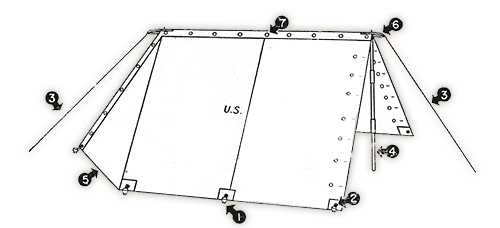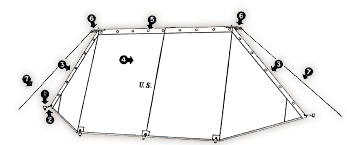When individual Tents, Shelter Half, are authorized, the normal basis of issue per individual is one Tent, Shelter Half, with the required number of pins and poles. Thus, two individuals carry and occupy one complete Tent, Shelter. There are two types of Shelter Half: the Tent, Shelter Half (Old Type) and the Tent, Shelter Half, New Type. The Tent, Shelter Half, New Type is issued when available, but the old type will be issued until the supply is exhausted. The only difference between the two types is that the new type has a triangular piece at both ends which makes it possible to close the tent completely. This new type is superior, particularly for use in cold climates and for protection against wind and rain. In addition to its use as sleeping quarters, the Shelter Half may also be used as a fly to protect a man while cooking. A Shelter Half with the necessary number of pins and poles is an individual item of issue. It becomes the responsibility of the individual to whom it is issued and it will usually be carried as part of the field pack.
Tent, Shelter (Old Type):

1: 10 x Pins, Tent, Shelter, Wood (Stock No. 74-P-125)
2: 8 x Lines, Foot Stop, Tent, Shelter Half (74-L-67)
3: 2 x Lines, Guy, Tent, Shelter Half (74-L-70)
4: 2 x Pole, Tent, Shelter (74-P-225)
5: Triangular End Piece
6: Loop
7: Buttons
Characteristics:
(1) The back of the tent is shaped like an inverted “V”, and the front is open.(2) This tent is made of 33-inch wide, 7.9 ounce cotton duck material which has been treated with aluminium acetate, wax and soap to make it highly water repellent. It comes in two sections which button together to make it into a two-man tent.(3) It has a ridge height of 43 inches.(4) Added ventilation may be secured by opening the closed end of the tent as desired.
Pitching:
The purpose of instructing men in formal Shelter Tent pitching is to enable the unit commander to establish his unit effectively and rapidly in Shelter Tents. Except at forma inspections, the employment of the best available ground for concealment and for the comfort of the men. will have priority over specific alignments and intervals between tents. However, the principles of pitching the tent will be the same. In the field, it takes one man approximately 7 minutes to erect this tent, but it can be done in much less time when two men erect the tent. The Officer or Noncommissioned Officer in charge indicates the area for each Platoon (or Section) or the line on which its tents are to be pitched.
Formal Shelter Pitching:
(a) The Platoons or Sections are formed for formal Shelter Tent pitching as prescribed in FM 22-5. When directed by the Officer in Charge, each odd-numbered marks his position with the outside left of his left heel near the instep. The locations marked thus indicate the positions of the front tent poles. Odd and even numbers pitch tents together.
(b) When the command for pitching tents is given, each man (if armed with a rifle) steps off obliquely with the right foot a full pace to the right front, and lays his rifle on the ground, muzzle to the front, barrel to the left, butt near the toe of his right foot. He then steps back into place. All men then unsling equipment and place their packs (or rolls) on the ground in front of them, Haversacks (Saddlebags or Field Canvas Bags) up and to the front, the packs two paces in front of the men’s positions. Each man then opens his pack and removes his Shelter Half Poles, and Pins. Each odd-numbered man places a pin in the ground on the spot which he previously marked with his left heel. Each man of each pair spreads his Shelter Half on the ground which the tent is to occupy, buttons to the center, triangle to the rear, the even-numbered man’s Shelter Half being on the left. It will be necessary to see that one of the halves is right side out and that the other is inside out, otherwise both rows of buttons and buttonholes will not match for fastening. The right side of the tent can be determined by the letters “U.S.” stamped thereon.
(c) They then button the halves together. The odd-numbered man adjusts his pole through the eyelets in the front of the tent and holds the pole upright in position beside the pin. The even-numbered man pins down the front corner of the tent in line with the pins. He then drives the front guy pin a tent-pole length ahead of the front pole. The even-numbered man places the loop of the guy line over the front guy pin, runs the other end of the line through the loops of the Shelter Halves and ties it, making sure that the pole is vertical when the line is taught. He then adjusts the rear tent pole through the eyelets in the rear of the tent. The odd-numbered man pins down the rear of the tent and drives the rear guy pin so that it is two and one-half tent-pin lengths from the rear pin of the triangle. He then adjusts the guy line. The even-numbered man then drives the remaining pins on the left of the Shelter Tent and the odd-numbered man drives them on the right.
Pitching Double Shelter Tents:
(a) This tent may be pitched singly, or two tents may be pitched together as a double Shelter Tent. The double-tent camp is preferable to the single-tent camp in cold or inclement weather because of the added shelter it affords. It is useful in restricted areas because of its greater concentration of personnel. The double tent is composed of two Shelter Tents (Old Type) buttoned together at the square ends. The tent is supported by three poles, one in the center and one at each end. Double Shelter Tents can be used only with the Shelter Tent (Old Type) because the New Type has built-in double ends.
(b) On direction of the Officer in Charge, one man marks the position of the front pole with the outside of his left heel, near the instep and places a pin in the ground at this spot. The four men of each group pitching tents together spread their Shelter Halves on the ground which the tent is to occupy. The men button together the four Shelter Halves of each tent, the ridge first and then the square ends so that the center eyelets of the Shelter Halves will be in the following order starting at the bottom: the lower half of the front tent, the lower half of the rear tent, the upper half of the front tent, and the upper half of the rear tent. Two men insert and support the front and rear poles, respectively, the front pole in the location marked, the rear pole in a line with it. The other two men pin the front and rear corners of the tent. One man enters the tent with the pole and assisted by another man, inserts the pole through the center eyelets of the Shelter Half.
(c) Two men drive two guy pins at each end of the tent one tent-pole length from the corner pins of the tent and on line with the side pins. Then at each end of the tent they adjust the guy lines through both loops at once and fasten them. They drive the remaining pins.
Striking:
To strike Shelter Tents, the men first unbutton sufficient buttons to grasp the tent poles and then let them fall either to the left or to the right. When the tent is flat on the ground they pull the pins, unbutton the Shelter Halves and roll their packs.
Tent, Shelter (New Type):

1: 10 x Pins, Tent, Shelter, Wood (Stock No. 74-P-125)
2: 10 x Lines, Foot Stop, Tent, Shelter Half (74-L-67)
3. Doors
4. 2 x Tent, Shelter Half, New Type (74-T-102)
5. Buttons
6: Loop
7: 2 x Lines, Guy, Tent, Shelter Half (74-L-70)
Characteristics:
The characteristics of this tent are the same as those of the Tent, Shelter (Old Type) with the following exceptions:
(1) It has an added V-section on the front end.
(2) It may be ventilated by opening one end or both ends as desired.
Pitching:
The Tent, Shelter, New Type is pitched in the same manner as the Tent, Shelter (Old Type) with the following exceptions:(1) When spreading the Shelter Halves preparatory to buttoning them together, both halves should be right side out with buttons to the center and the even-numbered man’s Shelter Half on the left.(2) After the front corner pins of the tent have been driven, the even-numbered man pins down the front of the tent. He then drives the front guy pin so that it is two and one-half tent-pin lengths from the front pin of the triangle, or the distance from the base of the front tent pole to one of the front pins.
Striking:
The process for striking the Tent, Shelter, New Type is identical to that of the Old Type (see above).

